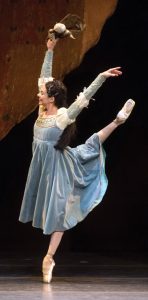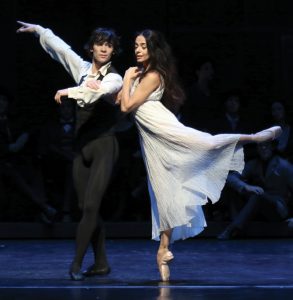In Conversation with Alessandra Ferri - Vancouver Ballet Society
- Home
- Features 2015 - 2019
- In Conversation with Alessandra Ferri

by Gary Smith
Stepping into the bar of Hamburg’s Side Hotel, a deconstructionist building with ugly lobby lights, Alessandra Ferri wraps her pale, diaphanous shawl tighter around her shoulders. Sitting gingerly on an uncomfortable banquette, she orders tea. “Herbal tea,” she says. “No caffeine, it’s lethal, caffeine and jet lag.”
Ferri smiles one of her sweet smiles, which you recognize from when she played Juliet more than 30 years ago at Covent Garden. “That was a long time ago,” she grins. “But life has a way of bringing you back, of helping you rediscover moments. Sometimes you have to come full circle to find out who you are and where you are going.”
The tea arrives, and Ferri sniffs its heady aroma. “You’re sure there’s no caffeine?” she asks the waiter before taking a sip.
Born in Milan 53 years ago, Ferri trained at La Scala Ballet School. She was attracted to the musicality of dance, especially ballet. At 15, she joined London’s Royal Ballet. At 19, she became one of the youngest principal dancers at Covent Garden.In some perfectly logical way, she became a muse of the great Sir Kenneth MacMillan and the darling of the London ballet set. When she suddenly left for New York and American Ballet Theatre two years later, London fans were devastated. “I left because Misha [Mikhail Baryshnikov], director of the company then, asked me to dance at ABT. I was 21 and it was a great offer. Of course, I didn’t plan any of it. I just did it. And, yes, I missed the Royal Ballet. It was my home, but you need to go out and see the world.”

New York wasn’t easy, Ferri admits. “In London, you were nurtured, given everything you needed. In New York, it was, ‘Here’s your costume. Get out there and do it. If you don’t, someone else will.’”
Despite the success she achieved in her career, Ferri quit dance at 44.
“You reach an age where you start comparing yourself with who you once were. Things were changing around me. I felt in a single moment an era of my life was finished. I just wanted to step away,” she explains. “I lived for my children and thought they needed me. I gave up exercising. I was happy just being who I am. Ultimately I realized something was missing. Being a parent doesn’t have to mean sacrificing yourself. My life was getting smaller and that was wrong.”
Ferri discovered her two daughters, Emma and Matilde, now 15 and 18, had lives of their own and felt happy at home in New York City where they lived with their mother. (Ferri and their father, a photographer, are divorced.)
“They’re Italian, my daughters, but they are American, too, with busy lives,” she says. “And I began to go to Pilates and exercise class, and to rebuild my strength. Pain? Of course there is pain. That’s always been there. It’s part of a dancer’s world. You work beyond such things.”
In 2013, Ferri returned to dance in The Piano Upstairs, which she choreographed for Spoleto Festival. It was an important taste of something she craved. “Then I did Chéri for Martha Clarke at Signature Theater in New York and Woolf Works by Wayne McGregor for the Royal Ballet in 2015.” When artistic director Kevin Mackenzie suggested she dance Juliet again with American Ballet Theatre, she said, “Why not?”
“Of course it was risky. And, yes, it was courageous. But a whole new chapter opened in my life. Margot Fonteyn danced Juliet when she was 60. So, I just said yes.”
When she returned to the role this July in New York, Ferri cast off memories of her earlier Juliet. “It was important not to remember how it felt back then. I had to not go down that road. At the premiere, I felt such honesty and truth onstage that night. Everything I had learned stayed with me and I used that. I had a wonderful partner in Herman Cornejo. I didn’t want to dance with someone I had danced Juliet with before. It had to be all new.”
Ferri doesn’t deny her age and the effect that has on performance. “When you’re young, you only understand the early part of Juliet’s story. You need to understand how a dream can shatter. This time I wasn’t performing the role. I was there, myself, the whole of myself. I wasn’t afraid of the silence. I wasn’t afraid of being still.”
Was there pressure to be good? “Of course there was,” she smiles. “Pressure is something you put on yourself. I’m very demanding, I know that, but my body somehow does what I want it to.”
Her latest dramatic creation, the role of Eleanora Duse in John Neumeier’s new ballet, Duse, premiered at the Hamburg Opera House in December 2015. The work about the great Italian actress is in many ways a confrontation between two stars.
“The parallels are interesting,” Ferri says. “Duse was a very different person from me, but we shared experiences. I relate to her in many ways. It’s important to remember she was an enormous star in North America, too, even though she didn’t perform in English. I cannot become someone else, but I lend myself to the character and the role. She was so truthful onstage. She shared her most intimate moments, her human self.”
Watching Ferri define the essence of Duse in Neumeier’s ballet is to understand what theatrical illusion can be. At its best it is real and compelling, and Ferri finds the moments of theatre in Duse’s life. There again onstage are her performances as Camille, Cleopatra and Juliet. There are her love affairs with beautiful young men. There are the passions that fueled not just her performances, but also a lifetime of art.
“You stop thinking, you forget about yourself. You give your soul to the role you dance and don’t feel afraid to go there. Dancing is about how you use your body to create. I don’t feel younger, you understand, but I hope I look it onstage.”
Ferri acknowledges that creation is harder now. “I have to take time to rest. I have to sleep. There’s no coming home at two in the morning. I’m like a racecar, I need more time in the box.”
Ferri will continue to dance as long as there are offers and audiences. Duse proves she has something new and thrilling to offer.
“I love the way John has fashioned Duse with jumbled memories, a non-linear thrust, different ages all tossed together. He broke the line between fantasy and reality. It’s just like real life.”
For Ferri, a whole new chapter has opened and she’s prepared to live it. “Well, in a way, I feel my career is over. What I do now is just about joy. I’m not so concerned about dance, not so frightened. It’s just something that makes me happy. I don’t feel I need to impress anymore.”
For a moment there is silence. Then Ferri looks at her hands. There are wrinkles now. Each is beautiful and real.
“Like Duse, I want to get at the truth. Her strength came from the courage of being herself. That’s what John’s ballet is about. It’s amazing how art can erase for a moment all the ugliness around and leave us with a bit of beauty.”

Photo: Holger Badekow
